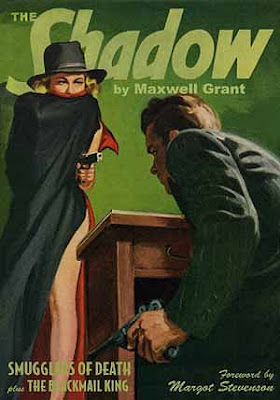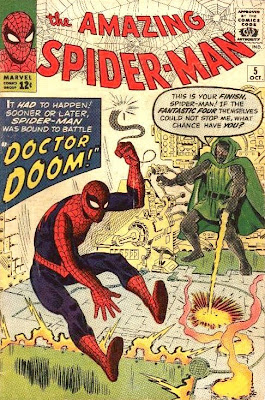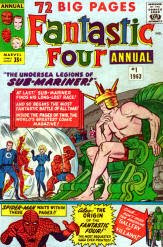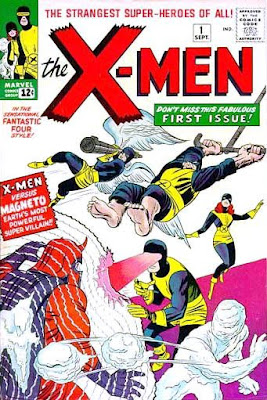
TALES OF SUSPENSE #46
A Communist scientist—the world’s foremost expert on electricity—creates a powered suit he calls the Crimson Dynamo. Sneaking into the U.S., he begins a campaign of sabotage against Stark Industries.
Things get so bad that Tony is soon worried about bankruptcy and the government begins to suspect him of sabotaging his own factories. But eventually, Iron Man and the Dynamo confront each other. The Russian is defeated and Tony clears his name.
Iron Man continues to have pacing problems. Once again, a large percentage of this relatively short story is spent setting up the story and introducing the villain. Consequently, his encounter with Iron Man is fairly short, with Tony winning far too easily. Oh, well—the Dynamo (with someone else wearing the suit) will eventually be more of a challenge.
There is a nice twist at the end of the story. After defeating the Dynamo, Tony gets him to defect by playing him an intercepted radio message about the Russian being assassinated by the Commies after his mission is over. At first, this seems too much of a dues ex machina, but then it turns out that Tony
faked the message. Devious of you, Tony, but kinda cool all the same.

TALES TO ASTONISH #48
Henry Pym seems to run into an awful lot of disgruntled scientists.
This time around, it’s a disgruntled Defense Department researcher who feels the battle suit he designed is unappreciated. The suit is modeled on the porcupine and bristles with quills that are actually a variety of different weapons.
Using this suit, the self-styled Porcupine robs a bank. Ant Man tracks him down, but gets captured and is nearly drowned in a bathtub before the Wasp rescues him. They then defeat the Porcupine by clogging his weaponry with liquid cement. The villain gets away at the end, but the heroes are safe (and they presumably recover the loot from the bank job—though writer H.E. Huntley seems to have forgotten about that).
The Porcupine is a pretty good idea for a villain—though he can’t help but look a little silly. As is typical of many Ant Man stories, this one is good but not really memorable or exceptional in any way.
But things will be looking…. UP… for Henry Pym in the next issue.
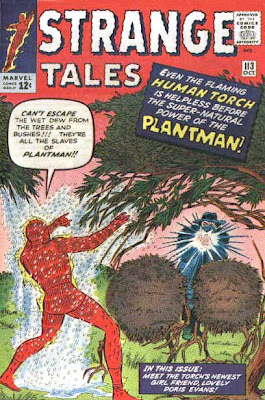
STRANGE TALES #113
This story gives us the first appearance of Dorrie Evans—Johnny’s first-ever regular girl friend. She’ll never be an important part of the Marvel Universe, but she’ll pop up from time to time both here and in the FF for a little while.
Johnny and Dorrie’s first date actually manages to set up a potentially interesting relationship. Dorrie likes Johnny despite his being the Human Torch—all that flaming on actually annoys her. For his part, Johnny is both pleased to be liked for himself and a little bothered that he can’t use his powers to show off for her like he does with other girls.
Oh, yes, there’s also a supervillain. The Plantman has a ray that increases the intelligence and mobility of plants, allowing him to command them to assist in committing crimes. After framing Dorrie’s father for a burglary, though, he moves on to thoughts of world conquest—figuring that plants far outnumber us mere humans.
But Johnny manages to get the best of him, using a fire ball to dry out the plants that are attacking him and forcing all that vegetation to realize that Plantman is just getting them in trouble. The plants turn on the bad guy and wreck his ray gun.
Interestingly, Plantman himself manages to make a getaway after the plants all revert to normal. This is a good month for villains who need to escape—Doctor Doom, Porcupine and now Plantman all manage to do so.
That’s it for October 1963, bringing the second full year of the modern Marvel universe to an end. We now have three groups of heroes active (the FF, the Avengers and the X-Men), with the Avengers all maintaining their solo careers as well. Spider Man is well-established and has already added several important members to his rogue’s gallery. I’ve long since lost count of how many times Earth has been invaded by aliens and we’ve been introduced to two or three subterranean and one sub-atomic civilizations. Just about everyone has had a chance to do some time traveling and the FF has been to the moon and to another planet.
The Marvel Universe is really starting to fill up, but before another year goes by, we’ll see yet another important hero—a blind lawyer in a brightly colored costume—join the pantheon. The Hulk will get his own series again. Kirby and Ditko will continue to produce absolutely astounding visuals and nifty-keen fight scenes.
But we’ll still be taking it in one month at a time. In November 1963, the FF and the X-Men will each encounter a new villain, while Dr. Strange fights an old enemy; a “possessive” alien will cause some internal strife among the Avengers; Ant Man will expand his powers; yet another new villain will give Iron Man a hot time; Spider Man will meet a one-armed scientist who will prove to be both a good friend and a dangerous enemy; Thor will continue to have girl friend troubles; and the Human Torch will meet a certain Living Legend from World War II... or will he?





